Installation Procedure
You can run the Message Queue Installer in either of two modes:
-
In GUI (graphical user interface) mode, the Installer presents a series of graphical screens with which you interact using mouse clicks and keyboard text entry.
-
In silent mode, the Installer operates from a predefined answer file representing your responses to the GUI screens. This allows you to script the installation process in advance and then perform it in batch mode without actually displaying the GUI screens and responding to them interactively.
The following sections describe each of these two modes of Installer operation.
Installing in GUI Mode
The following procedure shows how to use the Message Queue Installer in GUI mode to install the Message Queue 4.3 product on your Windows system.
 To Install Message Queue in GUI Mode
To Install Message Queue in GUI Mode
-
Download the Message Queue Installer.
The Installer is available for download from the Message Queue product Web site at
http://www.sun.com/software/products/message_queue
It is distributed as a compressed archive (.zip) file named
mq4_3-installer-WINNT.zip
-
Decompress the Installer archive.
-
Open the Installer folder.
Double-click on the mq4_3-installer folder to open it in Windows Explorer.
-
Start the Installer.
Locate the Installer executable (a VBS script) and double-click to launch it. The Installer’s Welcome screen (Figure 5–1) appears.
Figure 5–1 Installer Welcome Screen
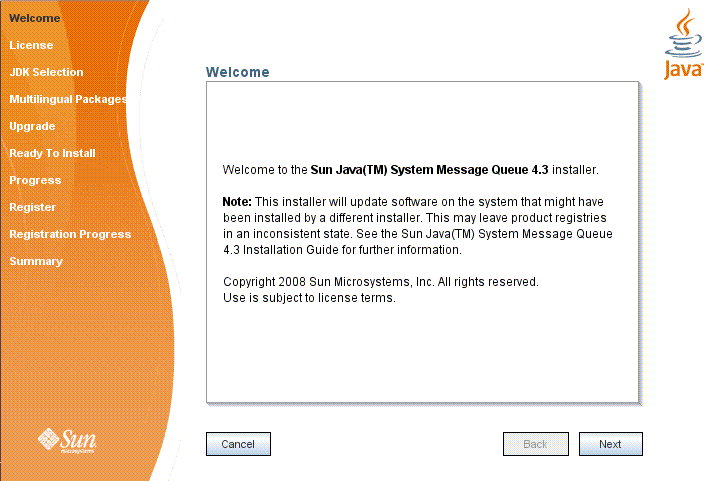
-
Click the Next button.
The Installer’s License screen (Figure 5–2) appears.
Figure 5–2 Installer License Screen
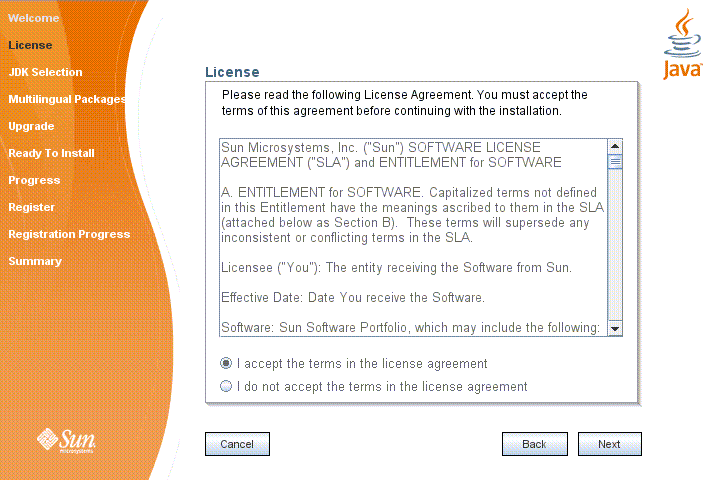
-
Read and accept the product license agreement.
Installation and use of the Message Queue product are subject to your acceptance of the license agreement. You must read and accept the terms of the license agreement before installing the product.
-
Read the product license agreement.
-
Make sure the radio button labeled “I accept the terms in the license agreement” is selected.
If you instead select “I do not accept the terms in the license agreement,” the Next button becomes disabled. You cannot proceed with installation without accepting the license terms.
-
Click the Next button.
The Installer’s Install Home screen (Figure 5–3) appears.
Figure 5–3 Installer Install Home Screen
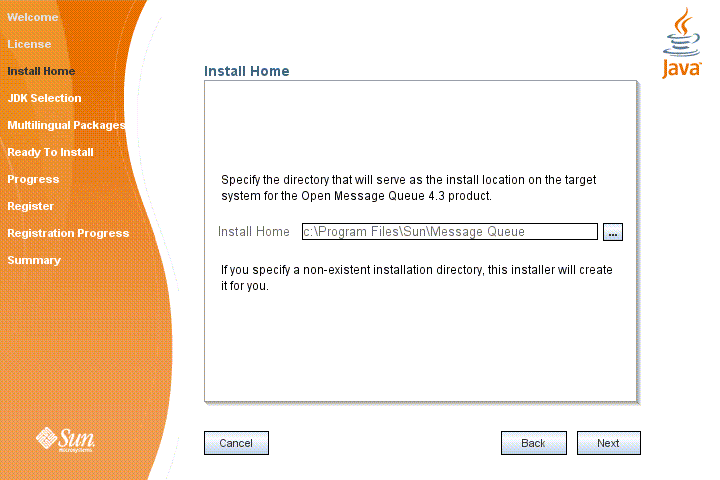
-
-
Specify the home directory in which to install Message Queue.
-
Provide the location of the installation home directory.
Enter the path to the installation home directory in the text field, or use the button marked with an ellipsis (…) to browse to it interactively.
Note –If you enter a path to a directory that does not exist on your system, the Installer will create the directory for you automatically.
-
Click the Next button.
The Installer’s JDK Selection screen (Figure 5–4) appears.
Figure 5–4 Installer JDK Selection Screen

-
-
Specify the version of the Java SDK for Message Queue to use.
-
Select a Java SDK.
You can do this in either of two ways:
-
Choose an SDK already installed on your system.
The drop-down menu under the option “Choose a Java SDK from the list below” lists existing SDKs found in standard locations on your system. You can use this option to specify one of these SDKs for Message Queue to use.
-
Provide an explicit path to an existing SDK.
To use an SDK from a location other than the standard ones, enter its path in the text field under the option “Type in a Java SDK location below,” or use the button marked with an ellipsis (…) to browse to it interactively.
Note –The third option in the JDK Selection screen, “Install and use the default version of the Java SDK,” is intended for use on other platforms; it is disabled and unavailable for Windows installation.
Tip –After installation is complete, you can check which version of the Java runtime Message Queue is using with the command
imqbrokerd -version
-
-
Click the Next button.
The Installer’s Multilingual Packages screen (Figure 5–5) appears.
Figure 5–5 Installer Multilingual Packages Screen

-
-
Specify whether to install multilingual packages.
By default, Message Queue is installed to operate in the English language only. The Multilingual Packages screen allows you to install it for use in another language.
-
If you will be using Message Queue in a language other than English, select the checkbox labeled “Install Message Queue multilingual packages.”
If you will be using Message Queue only in English, leave this checkbox deselected.
 Caution –
Caution – If you choose not to install the multilingual packages and later decide that you do need them after all, there is no convenient way to install them incrementally: you will have to uninstall Message Queue and then repeat the entire installation procedure with the multilingual packages selected. Before proceeding to install without the multilingual packages, be sure you will not be needing them in the future.
-
Click the Next button.
The Installer’s Ready screen (Figure 5–6) appears.
Figure 5–6 Installer Ready Screen

-
-
Click Install to begin the installation.
The Installer’s Progress screen (Figure 5–7) appears, tracking the progress of the installation as it proceeds.
Figure 5–7 Installer Progress Screen

When installation is complete, the Installer's Sun Connection Registration screen (Figure 5–8) appears.
Figure 5–8 Sun Connection Registration Screen

-
Register Message Queue with Sun Connection.
Sun Connection is a Sun-hosted service that helps you track, organize, and maintain Sun hardware and software. When you register a Message Queue installation with Sun Connection, information such as the release version, host name, operating system, installation date, and other such basic information is securely transmitted to the Sun Connection database. The Sun Connection inventory service can help you organize your Sun hardware and software, while the update service can inform you of the latest available security fixes, recommended updates, and feature enhancements.
Registration requires that you have a Sun Online account or create one. If you do not already have an account, the installer provides the following screen (Figure 5–9) for creating a Sun Online account:
Figure 5–9 Create Sun Online Account Screen
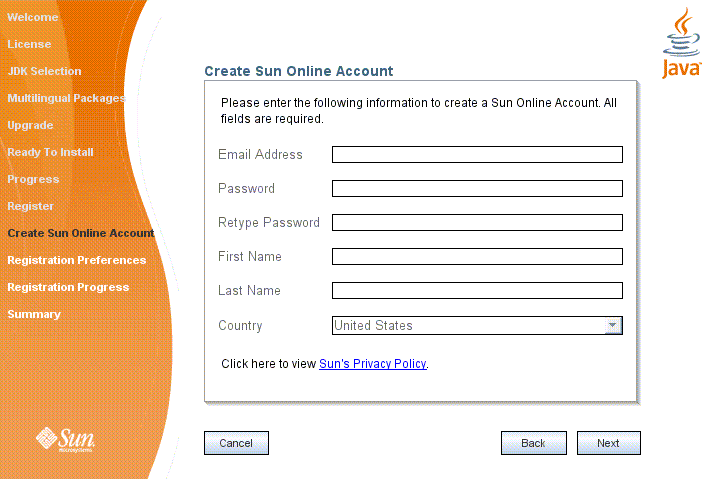
Note –If you choose not to register Message Queue during installation, you can subsequently register Message Queue by running the installer in register-only mode, as follows:
# installer -r
The register-only mode requires that Message Queue 4.3 already be installed and will display only the installer screens related to registration.
When Sun Connection registration is complete, the Installer’s Summary screen (Figure 5–10) appears, summarizing the steps that were performed during installation.
Figure 5–10 Installer Summary Screen
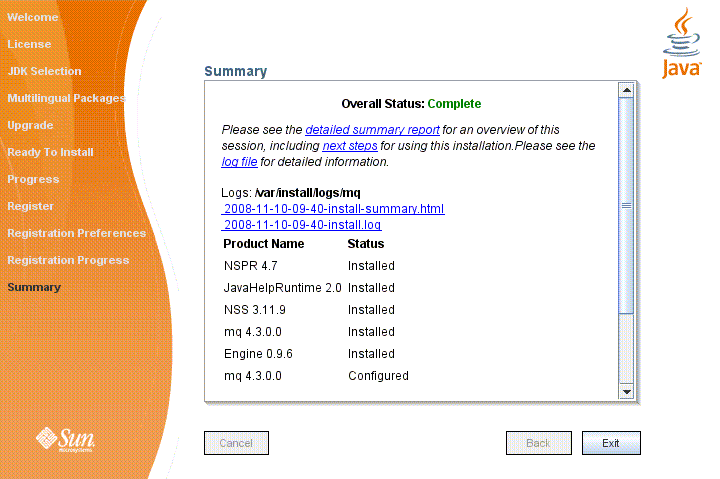
You can click the links on this screen for a detailed summary report and a log file giving more details on the installation.
-
Click the Exit button to dismiss the Summary screen.
Message Queue installation is now complete.
Tip –After installation is complete, you can check that the expected version of Message Queue has been installed by navigating to the mqInstallHome\mq\bin directory and executing the following command:
imqbrokerd -version
The output from this command identifies the versions of Message Queue and the Java SDK that are installed on your system.
Installing in Silent Mode
In silent mode, the Installer operates from a predefined answer file representing your responses to the GUI screens. This allows you to script the installation process in advance and then perform it in batch mode without actually displaying the GUI screens and responding to them interactively.
To create an answer file, start the Installer with the -n option:
installer -n answerFile
where answerFile identifies the file in which to record your responses. This causes the Installer to execute a “dry run,” presenting the sequence of GUI screens without actually performing the installation. Your input responses are recorded in the specified answer file. You can then perform the installation at a later time by starting the Installer with the -s (“silent”) option, specifying the same answer file:
installer -s -a answerFile
This performs a silent installation as defined by the answer file, without visibly displaying the GUI screens.
Manually Configuring the Java Runtime Environment
The Message Queue Installer’s JDK Selection screen is not the only way to specify a version of the Java Runtime Environment for Message Queue to use. The JRE used by the Message Queue command line utilities (imqadmin, imqbrokerd, imqcmd, imqobjmgr, imqdbmgr, imqusermgr, imqkeytool) is determined by the following sources, in order of precedence:
-
The -jrehome or -javahome command line option to the imqbrokerd command. (If both are specified, the one occurring last on the command line takes precedence).
-
The J2SE file location specified in the jdk.env file. (This file is deprecated, but is still supported for backward compatibility. For historical reasons, it has higher priority than anything else except option 1.)
-
The IMQ_JAVAHOME environment variable.
-
The environment variable IMQ_DEFAULT_JAVAHOME in the imqenv.conf file.
-
The system default locations, as specified in the documentation for your platform.
To check which version of the Java runtime Message Queue will use, enter the command
imqbrokerd -version
The output from this command includes the version and pathname of the configured JRE: for example,
Java Runtime: 1.5.0_12 Sun Microsystems Inc. C:\Program Files\Java\jdk1.5.0\jre
When you specify a JRE location through the Installer’s JDK Selection screen, the Installer saves that location as the value of IMQ_DEFAULT_JAVAHOME in the imqenv.conf file (option 4 in the list above). On Windows, this file is located by default at
C:\Program Files\Sun\MessageQueue\etc\mq\imqenv.conf
After a successful Message Queue installation, it should include something like the following:
set IMQ_DEFAULT_JAVAHOME=C:\Program Files\Java\jdk1.5.0_12
You can override this setting, however, either by editing the imqenv.conf file or by setting one of the other options higher in the list. This can be useful, for instance, for testing or reconfiguring the broker when a newer JRE version becomes available. Understanding how the JRE is determined can also help in troubleshooting problems. For instance, if the imqbrokerd -version command shows that Message Queue is using an unexpected JRE, it may be that one of the higher-precedence options has been set inadvertently (such as by an old jdk.env file that should have been deleted).
Configuring Message Queue for Automatic Startup
To start a Message Queue message broker automatically at Windows system startup, you must define the broker as a Windows service. The broker will then start at system startup time and run in the background until system shutdown. Consequently, you will not need to use the Message Queue Broker utility (imqbrokerd) unless you want to start an additional broker.
To install a broker as a Windows service, use the Message Queue Service Administrator utility:
imqsvcadmin install
You can use the imqsvcadmin command’s -args option to pass startup arguments to the broker. For more information, see the sections “Automatic Startup on Windows” in Chapter 3, “Starting Brokers and Clients,” and “Service Administrator Utility” in Chapter 13, “Command Line Reference,” of the Message Queue Administration Guide.
- © 2010, Oracle Corporation and/or its affiliates
